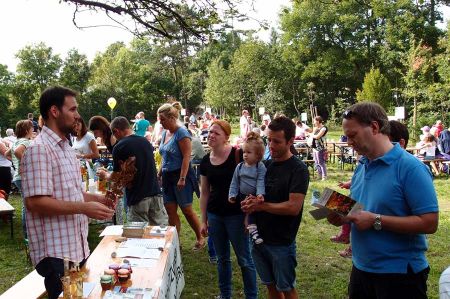Even the ancient Romans used the wood of the serviceberry!
- Written by Portal Editor
Right at the beginning of our project trip we met in Vienna the responsible coordinator and organizer of the Roman festival in Brunn am Gebirge, Dr. Krickl, who will also involve us in the upcoming Roman festival of 2015 in Brunn as we develop further contacts and share our common interests.
Exact information on the type and scope of the festival and our activities will follow in a timely manner.
The serviceberry - tree of the year
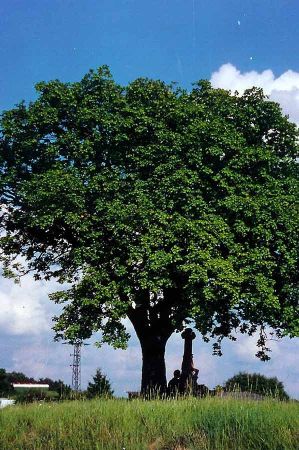 Now Dr. is writing to us. Krickl described an event that could be carried out as an important event in 2013, especially with a view to the Roman festival next year. There has been a beautiful tradition in Brunn am Gebirge for 15 years now: a tree is planted for every newborn citizen of a year. A tradition practiced in many countries. In the meantime, it has almost become a small forest - the year of life tree circle - which is located in a clearing on Brunner Berg. But let's let Mr. Krickl report himself:
Now Dr. is writing to us. Krickl described an event that could be carried out as an important event in 2013, especially with a view to the Roman festival next year. There has been a beautiful tradition in Brunn am Gebirge for 15 years now: a tree is planted for every newborn citizen of a year. A tradition practiced in many countries. In the meantime, it has almost become a small forest - the year of life tree circle - which is located in a clearing on Brunner Berg. But let's let Mr. Krickl report himself:
"After this tradition had already died down a bit, during the Brunner Roman Days from September 13th to 15th, 2013, a special focus was placed on the serviceberry - the tree of the year 2012. Although this wild fruit is native to us, It is largely unknown. The first detailed descriptions come from Roman authors, which was also explained at a separate stand and during guided tours, as well as the diverse uses of fruits, flowers and wood. On the tree of life of the children born in 2012, the serviceberry, which is native here, there was a separate information station that offered a lot of background information and reported on the first detailed descriptions by Roman authors. The highlight was a group photo with the newborns of the corresponding year with their tree of life:
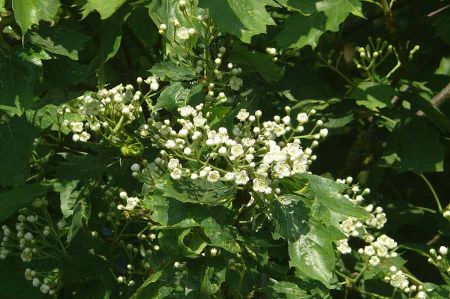 After the great response, a larger event was organized this year - on the occasion of the anniversary: On Saturday, September 6, 2014, all children of the last four years were invited to the unveiling of their year-of-life trees and plaques. A cherry (2010), a stone pine (2011), said service tree (2012) and a yew tree (2013) were planted for her. After speeches by the responsible municipal councillor DI (FH) Dieter Zelber and Brunner Mayor Dr. Andreas Linhart, was invited by them to eat and drink and all age groups had great conversations - sitting on benches, lying on picnic blankets between the trees or romping around in the meadow. For those who were interested I gave guided tours and at stations with illustrative material a lot of background and entertaining information about the year-of-life trees - often again with references to the Romans."
After the great response, a larger event was organized this year - on the occasion of the anniversary: On Saturday, September 6, 2014, all children of the last four years were invited to the unveiling of their year-of-life trees and plaques. A cherry (2010), a stone pine (2011), said service tree (2012) and a yew tree (2013) were planted for her. After speeches by the responsible municipal councillor DI (FH) Dieter Zelber and Brunner Mayor Dr. Andreas Linhart, was invited by them to eat and drink and all age groups had great conversations - sitting on benches, lying on picnic blankets between the trees or romping around in the meadow. For those who were interested I gave guided tours and at stations with illustrative material a lot of background and entertaining information about the year-of-life trees - often again with references to the Romans."
It was a very well-attended event that was felt by all to be extremely enjoyable. We would like to continue this tradition next year at the Roman Days in Brunn am Gebirge.
The serviceberry veneer is used for furniture carpentry
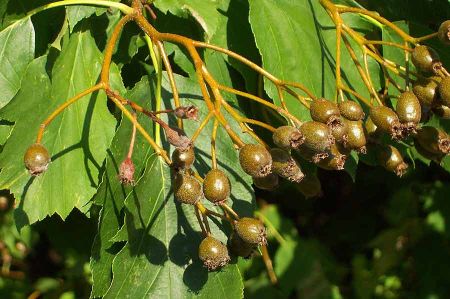 The wood of the service tree is one of the hardest European woods. It is sporadically porous, the core does not normally show a contrasting colour. It "works" and sheds a lot when drying, tough and at the same time elastic. Due to its similarity to pears, serviceberries are sold under the trade name Swiss pear tree.
The wood of the service tree is one of the hardest European woods. It is sporadically porous, the core does not normally show a contrasting colour. It "works" and sheds a lot when drying, tough and at the same time elastic. Due to its similarity to pears, serviceberries are sold under the trade name Swiss pear tree.
"Swiss pear tree" was used by many European manufacturers (e.g. Aristo, Faber-Castell, Albert Nestler Zeichentechnik) for the production of high-quality wooden slide rules.
The wood fetches very high prices, is light when fresh with a velvety surface (silk wood) and darkens to a reddish colour. The serviceberry veneer is used for furniture carpentry.
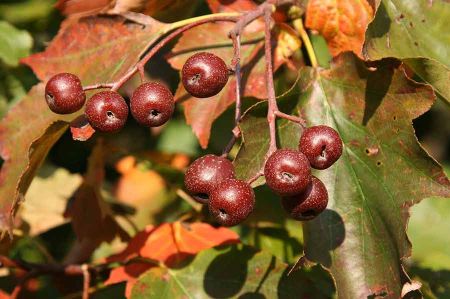 The small, apple-like fruits are edible but astringent, which comes from the Latin for astringere, "to attract, contract, constrict." For this purpose, among other things: the tannin responsible. Agents have an astringent effect which, when they come into contact with the skin or mucous membranes, have a drying, haemostatic and anti-inflammatory effect due to protein precipitation and lead to the compression of the colloid structure.
The small, apple-like fruits are edible but astringent, which comes from the Latin for astringere, "to attract, contract, constrict." For this purpose, among other things: the tannin responsible. Agents have an astringent effect which, when they come into contact with the skin or mucous membranes, have a drying, haemostatic and anti-inflammatory effect due to protein precipitation and lead to the compression of the colloid structure.
Astringents are used medically to stop bleeding from small blood vessels (alum stick) or in the treatment of inflammatory, weeping and itchy skin diseases, which was also known to the Romans.
Only when the serviceberry fruits are overripe or cooked is the tannin completely broken down. Overripe fruits are very popular with birds. That's why it's important to harvest the fruits on time. This must be done by hand; the fruits cannot be shaken off.
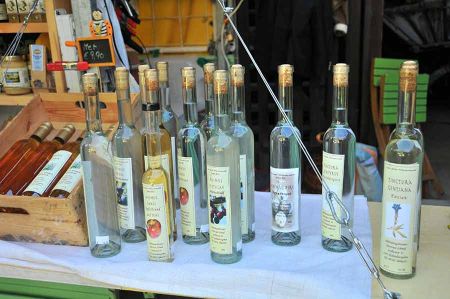 Even today, a schnapps with a taste similar to sloe schnapps is made in Alsace from the fruits of the service tree under the French name Alisier. In Austria it is called, in addition to Elsbeerenbrand, Adlitzbeerenschnaps (dial. Oadlatzbeerschnaps). However, the yield is very low: for 2 litres of schnapps you need 100 litres of mash. In Austria, the service fruit brandy with its home in Lower Austria is also listed in the register of traditional foods. The Wiesenwienerwald, a region in the western Vienna Woods, where the serviceberry is also processed or added to various products such as jam or honey, is marketed for tourism and culinary purposes under the Wiesenwienerwald Serviceberry brand.
Even today, a schnapps with a taste similar to sloe schnapps is made in Alsace from the fruits of the service tree under the French name Alisier. In Austria it is called, in addition to Elsbeerenbrand, Adlitzbeerenschnaps (dial. Oadlatzbeerschnaps). However, the yield is very low: for 2 litres of schnapps you need 100 litres of mash. In Austria, the service fruit brandy with its home in Lower Austria is also listed in the register of traditional foods. The Wiesenwienerwald, a region in the western Vienna Woods, where the serviceberry is also processed or added to various products such as jam or honey, is marketed for tourism and culinary purposes under the Wiesenwienerwald Serviceberry brand.
Please read as well:
